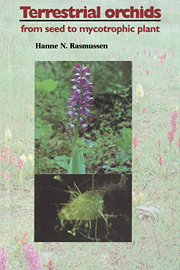Book contents
- Frontmatter
- Contents
- Acknowledgements
- Introduction
- 1 Properties of ‘dust’ seeds
- 2 Seed development
- 3 Seed survival
- 4 Requirements for germination
- 5 Fungi
- 6 Germination processes
- 7 Underground organs
- 8 Orchid mycorrhiza
- 9 Abiotic factors in growth and development
- 10 Life history and phenology
- 11 Propagation
- 12 Effects of orchid mycorrhiza
- 13 Descriptions of genera
- Appendix A Nutrient substrates mentioned in the text
- Appendix B Names and synonyms
- References
- Index
8 - Orchid mycorrhiza
Published online by Cambridge University Press: 13 October 2009
- Frontmatter
- Contents
- Acknowledgements
- Introduction
- 1 Properties of ‘dust’ seeds
- 2 Seed development
- 3 Seed survival
- 4 Requirements for germination
- 5 Fungi
- 6 Germination processes
- 7 Underground organs
- 8 Orchid mycorrhiza
- 9 Abiotic factors in growth and development
- 10 Life history and phenology
- 11 Propagation
- 12 Effects of orchid mycorrhiza
- 13 Descriptions of genera
- Appendix A Nutrient substrates mentioned in the text
- Appendix B Names and synonyms
- References
- Index
Summary
There are several early nineteenth century observations of disorganized clumps of material in the cortex of orchid roots, but Reissek (1847) may have been the first to realize that these clumps were the remains of fungal hyphae coiled inside the plant cells. He studied the roots of Neottia nidus-avis and observed tissues that were so young that living hyphae were still present. Reissek also reported these coils from roots of other European orchid species belonging to Orchis, Ophrys and Gymnadenia and from several tropical orchids. Some years later, ‘une matière granulaire’ originating from decomposed hyphal coils was observed in the basal cells of orchid protocorms (Prillieux & Rivière, 1856). These observations stimulated interest in orchid mycorrhiza, particularly as regards investigating the species that display marked chlorophyll deficiency (Prillieux, 1856; Johow, 1885, 1889; Groom, 1895; Janse, 1897; MacDougal, 1899a, b; Magnus, 1900).
In a survey of more than 500 cultivated orchid species, Wahrlich (1886) managed to find the characteristic fungal infections in every one of them, and Frank (1891) concluded from observations of the infected tissue that the hyphae became lysed, and that the nuclear modification in the infected cells was a sign of the active participation of the host in this process.
A more complete understanding of the functions of fungi in the life history of orchids arose from Bernard's germination studies during the years 1899 to 1909, and from Burgeff's study that primarily dealt with the fungi (1909). Both of these investigators succeeded in germinating orchids in vitro and in observing the process of infection in embryos and seedlings. Among the early investigators opinions differed as to the nature of the relationship.
- Type
- Chapter
- Information
- Terrestrial OrchidsFrom Seed to Mycotrophic Plant, pp. 142 - 173Publisher: Cambridge University PressPrint publication year: 1995
- 2
- Cited by

